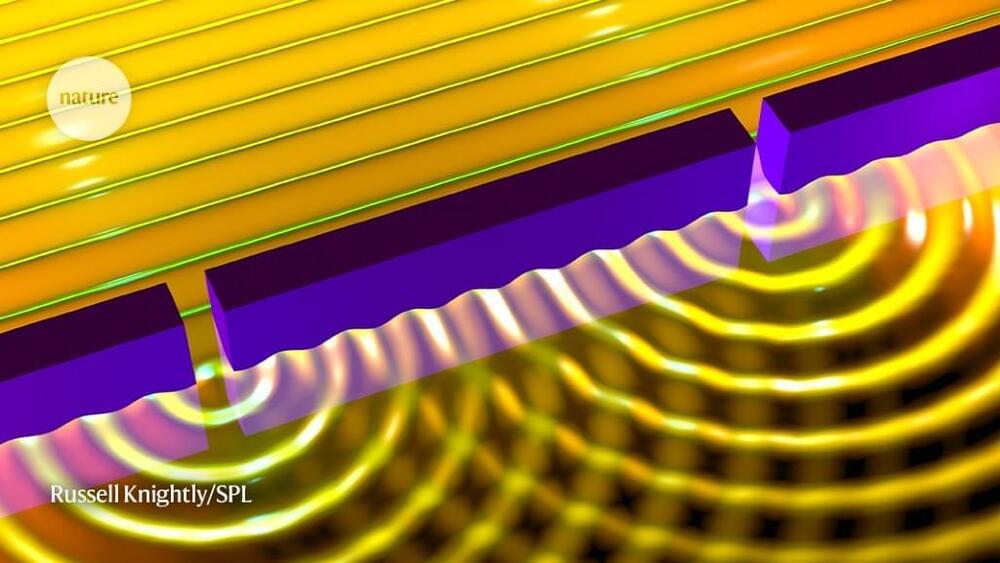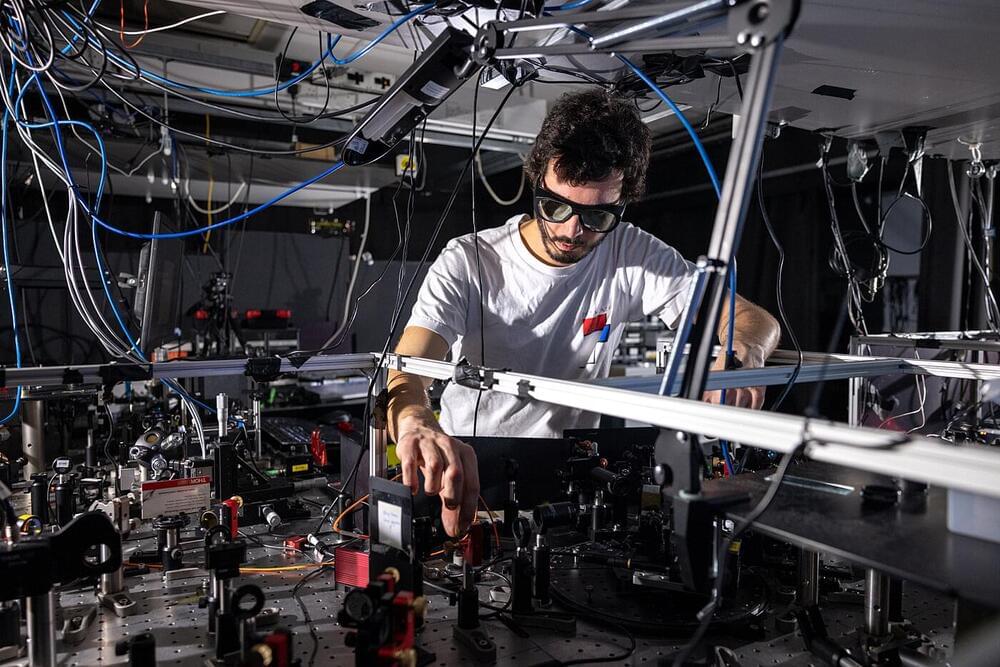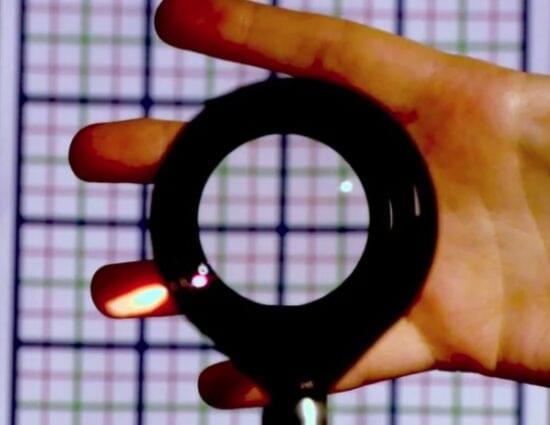Within the larger, “true” universe, ours could have branched off due to a random quantum fluctuation.



A celebrated experiment in 1,801 showed that light passing through two thin slits interferes with itself, forming a characteristic striped pattern on the wall behind. Now, physicists have shown that a similar effect can arise with two slits in time rather than space: a single mirror that rapidly turns on and off causes interference in a laser pulse, making it change colour.
The result is reported on 3 April in Nature Phys ics1. It adds a new twist to the classic double-slit experiment performed by physicist Thomas Young, which demonstrated the wavelike aspect of light, but also — in its many later reincarnations — that quantum objects ranging from photons to molecules have a dual nature of both particle and wave.
The rapid switching of the mirror — possibly taking just 1 femtosecond (one-quadrillionth of a second) — shows that certain materials can change their optical properties much faster than previously thought possible, says Andrea Alù, a physicist at the City University of New York. This could open new paths for building devices that handle information using light rather than electronic impulses.

Presented by Madhumita Murgia and John Thornhill, produced by Josh Gabert-Doyon and Edwin Lane. Executive producer is Manuela Saragosa. Sound design by Breen Turner and Samantha Giovinco. Original music by Metaphor Music. The FT’s head of audio is Cheryl Brumley. Special thanks to The Hospital for Sick Children.
We’re keen to hear more from our listeners about this show and want to know what you’d like to hear more of, so we’re running a survey which you can find at ft.com/techtonicsurvey. It takes about 10 minutes to complete and you will be in with a chance to win a pair of Bose QuietComfort earbuds.

In a demonstration that promises to help scale up quantum computers based on tiny dots of silicon, RIKEN physicists have succeeded in connecting two qubits—the basic unit for quantum information—that are physically distant from one another.
Many big IT players—including the likes of IBM, Google and Microsoft—are racing to develop quantum computers, some of which have already demonstrated the ability to greatly outperform conventional computers for certain types of calculations. But one of the greatest challenges to developing commercially viable quantum computers is the ability to scale them up from a hundred or so qubits to millions of qubits.
In terms of technologies, one of the front-runners to achieve large-scale quantum computing is silicon quantum dots that are a few tens of nanometers in diameter. A key advantage is that they can be fabricated using existing silicon fabrication technology. But one hurdle is that, while it is straightforward to connect two quantum dots that are next to each other, it has proved difficult to link quantum dots that are far from each other.

Imperial physicists have recreated the famous double-slit experiment, which showed light behaving as particles and a wave, in time rather than space.
The experiment relies on materials that can change their optical properties in fractions of a second, which could be used in new technologies or to explore fundamental questions in physics.
The original double-slit experiment, performed in 1,801 by Thomas Young at the Royal Institution, showed that light acts as a wave. Further experiments, however, showed that light actually behaves as both a wave and as particles—revealing its quantum nature.

The invisibility cloak that Harry Potter wears in J. K. Rowling’s books is woven from the hair of a magical creature. But in the real world, the magic of invisibility is not dependent on fantasy, but rather on science and engineering.
Then there is quantum stealth technology that uses colouration patterns to hide objects in plain sight.
There are even camouflage technologies that make something as large as a tank appear to be local foliage, absorbing the characteristics of the organic and inorganic materials found on a battlefield.
As cool as Harry Potter’s cloak of invisibility appears to be, current and future materials science discoveries and technological advancements may have it beat.

face_with_colon_three year 2022.
AdS/CFT Proves Its Usefulness
One of the first uses of AdS/CFT had to do with understanding black holes. Theoreticians had long been grappling with a paradox thrown up by these enigmatic cosmic objects. In the 1970s Stephen Hawking showed that black holes emit thermal radiation, in the form of particles, because of quantum mechanical effects near the event horizon. In the absence of infalling matter, this “Hawking” radiation would cause a black hole to eventually evaporate. This idea posed a problem. What happens to the information contained in the matter that formed the black hole? Is the information lost forever? Such a loss would go against the laws of quantum mechanics, which say that information cannot be destroyed.
A key theoretical work that helped tackle this question came in 2006, when Shinsei Ryu and Tadashi Takayanagi used the AdS/CFT duality to establish a connection between two numbers, one in each theory. One pertains to a special type of surface in the volume of spacetime described by AdS. Say there’s a black hole in the AdS theory. It has a surface, called an extremal surface, which is the boundary around the black hole where spacetime makes the transition from weak to strong curvature (this surface may or may not lie inside the black hole’s event horizon). The other number, which pertains to the quantum system being described by the CFT, is called entanglement entropy and is a measure of how much one part of the quantum system is entangled with the rest. The Ryu-Takayanagi result showed that the area of the extremal surface of a black hole in the AdS is related to the entanglement entropy of the quantum system in the CFT.

That means that these two people will say that the state of reality is different – they’d have different facts about where the particle is.
There are may other oddities about quantum mechanics, too. Particles can be entangled in a way that enables them to somehow share information instantaneously even if they’re light years apart, for example. This challenges another common intution: that objects need a physical mediator to interact.
Physicists have therefore long debated how to interpret quantum mechanics. Is it a true and objective description of reality? If so, what happens to all the possible outcomes that we don’t measure? The many worlds interpretation argues they do happen – but in parallel universes.

Having more tools helps; having the right tools is better. Utilizing multiple dimensions may simplify difficult problems—not only in science fiction but also in physics—and tie together conflicting theories.
For example, Einstein’s theory of general relativity —which resides in the fabric of space-time warped by planetary or other massive objects—explains how gravity works in most cases. However, the theory breaks down under extreme conditions such as those existing in black holes and cosmic primordial soups.
An approach known as superstring theory could use another dimension to help bridge Einstein’s theory with quantum mechanics, solving many of these problems. But the necessary evidence to support this proposal has been lacking.
The Big Bang may have not been alone. The appearance of all the particles and radiation in the universe may have been joined by another Big Bang that flooded our universe with dark matter particles. And we may be able to detect it.
In the standard cosmological picture the early universe was a very exotic place. Perhaps the most momentous thing to happen in our cosmos was the event of inflation, which at very early times after the Big Bang sent our universe into a period of extremely rapid expansion.
When inflation ended, the exotic quantum fields that drove that event decayed, transforming themselves into the flood of particles and radiation that remain today.